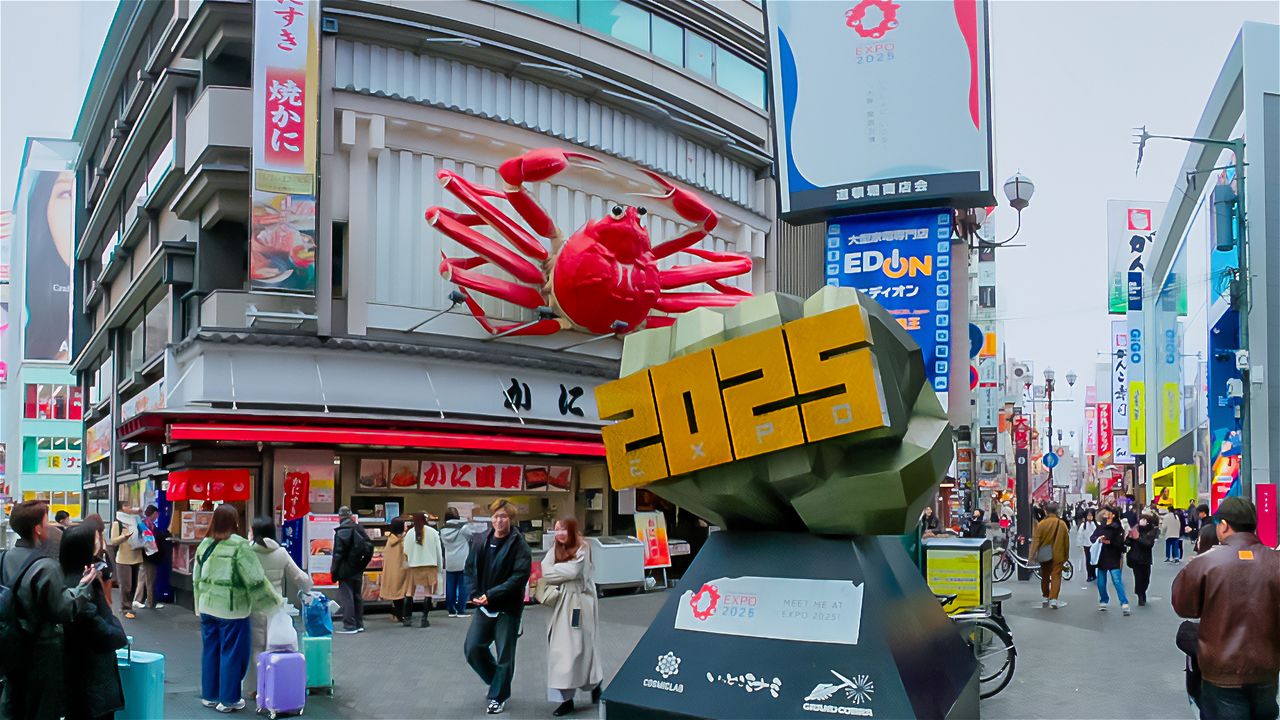
Osaka as Theme Park: Japan’s Second City as a Dining and Entertainment Destination
JapanIn video
Images Guide to Japan Travel- English
- 日本語
- 简体字
- 繁體字
- Français
- Español
- العربية
- Русский
◆Viewing the 180º video◆
- On PC, click and drag your mouse cursor to look around.
- In the YouTube app on your smartphone or tablet, the view changes with the movement of your device. You can also swipe to move the view around.
- Using VR goggles or headsets makes the experience all the more immersive!
Unique Streetscapes Bursting with Photo Opportunities
Selected by The New York Times as one of the “52 Places to Go in 2025,” the city of Osaka stands shoulder to shoulder with Tokyo as a leading international tourist destination. The city’s two major entertainment districts, Kita in the north and Minami in the south, are always bustling with visitors from abroad.

Ebisu Bridge, a popular photo spot in Dōtonbori. (© Somese Naoto)
At the heart of Minami lies Dōtonbori (in Chūō Ward), where local culinary favorites like takoyaki octopus dumplings and okonomiyaki are served at countless eateries. The streets are lined with extravagant 3D signs advertising crab, octopus, skewered cutlets, and more, each competing for attention. In front of Osaka’s iconic “Glico Sign,” a constant stream of people line up day and night to take commemorative photos, while sightseeing boats offering views of the city from the canal are also a big hit. Nearby, the Kuromon Ichiba (Kuromon Market) draws large crowds of international visitors looking to snack their way through fresh seafood and fruit offerings.

The Tonbori River Cruise offers views of the entertainment district from the water. (© Somese Naoto)

Takoya Dōtonbori Kukuru, a takoyaki shop with 40 years of history. (© Somese Naoto)
Heading further south brings you to Osaka’s symbolic tower, Tsūtenkaku (Naniwa Ward). Originally constructed for the Fifth National Industrial Exhibition in 1903, the current structure is the second generation, rebuilt in 1956 after the war. At the tower’s base stretches the Shinsekai shopping district, beloved for its retro atmosphere. The area is filled with casual gourmet spots serving fried skewers and grilled offal, as well as nostalgic attractions like shooting galleries and variety halls, exuding the charm of a classic downtown neighborhood. Everywhere you look, Tsūtenkaku’s official mascot Billiken greets you with a cheerful smile.

Shinsekai bustling with the lively atmosphere of a festival. (© Somese Naoto)

Billiken, a divine figure created by an American artist. Rubbing its feet is said to bring good luck. (© Somese Naoto)
Meanwhile in Kita, the area’s most prominent landmark is the Umeda Sky Building (Kita Ward), located near JR Osaka Station. From its Floating Garden Observatory, perched 173 meters above the ground, visitors can enjoy a spectacular 360-degree panoramic view. Looking out toward Osaka Station reveals Umekita Park, a 4.5-hectare green space born from a redevelopment project.

The observation deck of the Umeda Sky Building offers panoramic views of Osaka City. (© Somese Naoto)

Umekita Park at night in winter 2024. (© Somese Naoto)
In addition to Kita and Minami, a third area drawing increasing attention as a tourist destination in recent years is Nishi—the western coastal zone that includes Yumeshima (Konohana Ward), the site of Expo 2025 Osaka Kansai.
One of the biggest attractions in the coastal area, alongside Universal Studios Japan, is the popular Kaiyūkan aquarium (Minato Ward). Ranked among the world’s largest aquariums, Kaiyūkan is home to some 30,000 creatures representing around 620 species, including the whale shark, the largest species of fish on Earth. Its “Great Barrier Reef” aquarium, which spans three floors, was just renovated in November 2024 and showcases vibrant tropical marine life native to the coral reefs of Australia in impressive detail.

The Great Barrier Reef aquarium at Kaiyūkan, filled with a vibrant reproduction of a coral reef. (© Somese Naoto)
Osaka is also a city rich in history—it was once the site of an ancient capital. A prominent historical landmark is Osaka Castle Park (Chūō Ward). While no traces remain of the original castle built by Toyotomi Hideyoshi in 1585, the current main keep was reconstructed in 1931. Still, the people of Osaka affectionately call it Taikō-san no Shiro (Taikō’s Castle) in honor of Hideyoshi, also called by that name, who contributed greatly to the prosperity of the merchant city. Today, foreign tourists make up more than half of the castle’s visitors, and the observatory on the top floor of the keep is so popular that long lines are inevitable.

The tall stone walls surrounding Osaka Castle were built by the Tokugawa shogunate; a popular 20-minute boat tour circles the moat. (© Somese Naoto)
In 2024, Osaka Prefecture welcomed a record 14.6 million visitors from abroad. With the Expo year approaching, the city is preparing to welcome even more, offering a full array of umai-mon (delicious food) and omoroi-mon (fun and quirky experiences) to delight guests from around the world.

Nanba Yasaka Shrine, famous for its giant lion head, is worshipped for warding off evil and bringing prosperity in business. (© Somese Naoto)

Shitennōji temple, founded in the Asuka period, gave its name to the Tennōji district. (© Somese Naoto)

The Osaka City Central Public Hall on Nakanoshima is a nationally designated Important Cultural Property; many notable modern buildings remain throughout the city. (© Somese Naoto)
(Originally published in Japanese. Reporting and text by Nippon.com.)

